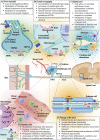Chemotherapy-induced peripheral neuropathy in children and adolescent cancer patients
- PMID: 36310587
- PMCID: PMC9614173
- DOI: 10.3389/fmolb.2022.1015746
Chemotherapy-induced peripheral neuropathy in children and adolescent cancer patients
Abstract
Brain cancer and leukemia are the most common cancers diagnosed in the pediatric population and are often treated with lifesaving chemotherapy. However, chemotherapy causes severe adverse effects and chemotherapy-induced peripheral neuropathy (CIPN) is a major dose-limiting and debilitating side effect. CIPN can greatly impair quality of life and increases morbidity of pediatric patients with cancer, with the accompanying symptoms frequently remaining underdiagnosed. Little is known about the incidence of CIPN, its impact on the pediatric population, and the underlying pathophysiological mechanisms, as most existing information stems from studies in animal models or adult cancer patients. Herein, we aim to provide an understanding of CIPN in the pediatric population and focus on the 6 main substance groups that frequently cause CIPN, namely the vinca alkaloids (vincristine), platinum-based antineoplastics (cisplatin, carboplatin and oxaliplatin), taxanes (paclitaxel and docetaxel), epothilones (ixabepilone), proteasome inhibitors (bortezomib) and immunomodulatory drugs (thalidomide). We discuss the clinical manifestations, assessments and diagnostic tools, as well as risk factors, pathophysiological processes and current pharmacological and non-pharmacological approaches for the prevention and treatment of CIPN.
Keywords: CIPN mechanisms; chemotherapy-induced peripheral neuropathy; neuroinflammation; pediatric cancer patients and survivors; pharmacological and non-pharmacological treatment strategies.
Copyright © 2022 Tay, Laakso, Schweitzer, Endersby, Vetter and Starobova.
Conflict of interest statement
The authors declare that the research was conducted in the absence of any commercial or financial relationships that could be construed as a potential conflict of interest.
Figures


References
-
- Agrawal V., Smelser D. T., Carey D. J., Vadakara J. J., Khan S. S. (2016). Effect of the CEP72 genotype and CYP3A5-mediated metabolism in predicting vincristine-associated peripheral neuropathy. Blood 128 (22), 5963. 10.1182/blood.v128.22.5963.5963 - DOI
Publication types
LinkOut - more resources
Full Text Sources

